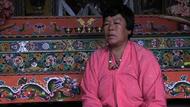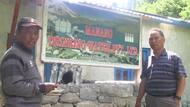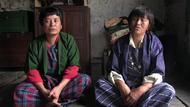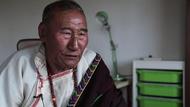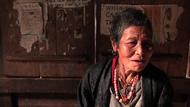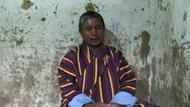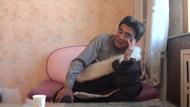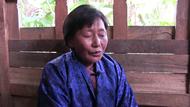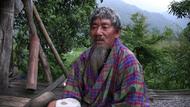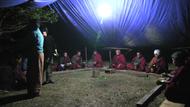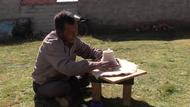Video Overview
༉ ལ་ཡག་རྒེད་འོག་སྐྱོང་ར་གཡུས་ཚན་ནང་ཡང་ ཁོང་རའི་སའི་ཆགས་ཚུལ་དང་ འདི་དང་བསྟུན་པའི་ལམ་སྲོལ་ཡོདཔ་བཞིན་དུ་ ཚེ་དབང་གིས་ ཁོ་རའི་གཡུས་ཁའི་ལོ་རྒྱུས་ཚུ་རྒས་ཤོས་ཚུ་ལས་གོ་ཡོདཔ་ད་ སྐྱོང་རའི་གཡུས་ཚན་འདི་ བྱང་ཁ་ཐུག་ལས་ ཀུ་ཅུ་གོའི་རི་མཚམས་ཚུན་ རྒྱ་ནག་གི་ས་མཚམས་ཡོདཔ་ད་ ལྷོ་ཁ་ཐུག་ལས་ཀི་ལའི་བ་ཟམ་དང་ ཤར་ཁ་ཐུག་ལུ་འཛོམས་རྡོ་ན་ ནུབ་ཁ་ཐུག་ལས་གླིང་གི་ཐང་ཚུ་གིས་མཐའ་བསྐོར་ཏེ་ཡོདཔ་ཨིན་མས། གཡུས་ཚན་འདི་ སྤོ་ཏོ་ཆུང་ཀུ་ཅིག་གུ་ཆགས་ཡོདཔ་ད་ དེ་ནང་ ཁྱིམ་གུང་ ༥༠ ལྷགཔ་ཅིག་སྤུངས་ཡོད་མི་ཁྱིམ་ཚུ་ཆ་མཉམ་ རྩིག་ཁྱིམ་ རྩི་ས་དབུར་ཞིནམ་ལས་ ཤིང་ཆས་ལག་ལེན་འཐབ་སྟེ་རྐྱབ་ཡོདཔ་ད་ དེ་ནང་མི་རློབས་ཡོངས་བསྡོམས་ ༢༠༠ ལྷགཔ་ཅིག་སྡོད་དོ་ཡོདཔ་ཨིན་པས། གཡུས་ཚན་དེ་ནང་ དང་ཕུ་དང་འཕྱདཔ་ད་ གོང་འཕེལ་གྱི་ལས་སྣ་ཚུ་ཡང་ ཡར་རྒྱས་སོང་ཡོདཔ་ད་ ཁྱིམ་གུང་ཆ་མཉམ་ནང་འཐུང་ཆུ་དང་གློག་མེའི་མཐུན་རྐྱེན་ཚུ་ཡོདཔ་མ་ཚད་ འགྲུལ་འཕྲིན་མོ་བཱལ་གྱི་མཐུན་རྐྱེན་ཚུ་ཡང་གཞི་བཙུགས་འབད་ཡོདཔ་ལས་ དང་ཕུ་དང་འཕྱདཔ་ད་ གོང་འཕེལ་སྦོམ་སྦེ་ར་སོང་བའི་རྟགས་མཚན་ཨིན་མས། དེ་བསྒང་ ཞབས་དྲུང་རིན་པོ་ཆེ་ལ་ཡག་སྐྱོང་ར་ལུ་བྱོན་པའི་སྐབས་ དགུང་ཞག་བཞུགས་ནི་སྦེ་ ཨ་དྲུང་གི་ཁྱིམ་ནང་བྱོནམ་ད་ ཁོ་གིས་བཞུགས་མ་བཅུགཔ་ལས་ ལྷགཔ་ཚེ་རིང་གི་ཁྱིམ་ནང་བྱོན་ཏེ་ དགུང་ཞག་གསུམ་བཞུགས་པའི་སྐབས་ གནམ་མེད་ས་མེད་ཐུགས་མཉེས་ཏེ་ བཀྲིན་དགའ་ཚོར་སྦེ་ ཁྲོ་ལུང་གསུམ་ ཞིང་ལུང་གསུམ་ གཡུ་ལུང་གསུམ་གནང་གནངམ་ཨིན་མས། ཏེ་ཞབས་དྲུང་རིན་པོ་ཆེ་མཆོག་ གཡུས་ནེ་ནང་ལས་བྱོན་པའི་སྐབས་ མ་འོངས་པའི་ལ་ཡག་གི་ལུང་ཕྱོགས་ནང་ འགོ་ཁྲིདཔ་འབད་མི་འདི་ སྐྱོང་ར་ལས་ཐོན་འོང་ཟེར་གསུངསམ་བཞིན་དུ་ སྤྱི་ལོ་ ༢༠༠༨ ལུ་ དམངས་གཙོའི་གཞུང་དབུ་མ་བརྙེས་ཚུན་ཚོད་ རྒཔོ་འདི་སྐྱོང་ར་ལས་ར་འབད་སྡོད་སྡོདཔ་མས། ལ་ཡག་ལུ་ཚེས་བཅུ་དང་དུས་སྟོན་ ག་ཅི་བཟུམ་ཅིག་འགོ་འདྲེན་འཐབ་རུང་ དང་པ་ར་སྐྱོང་ར་ལས་འགོ་བཙུགས་དོ་ཡོདཔ་ད་ དེ་ཡང་གཙོ་བོ་ར་ ཞབས་དྲུང་རིན་པོ་ཆེ་ བོད་ལས་འབྲུག་ལུ་བྱོན་པའི་སྐབས་ འགོ་ཐོག་དང་པ་ར་སྐྱོང་ར་ལུ་བྱོན་ནི་འདི་གིས་ཨིནམ་ད་ ལ་ཡག་ལུང་ཕྱོགས་ནང་སྐྱོང་རའི་གཡུས་ཚན་འདི་ རྒྱལ་རབས་ཅན་ཅིག་སྦེ་བརྩིཝ་ཨིན་མས།
- Pazhi
 Loading ...
Loading ... 